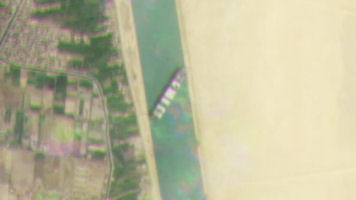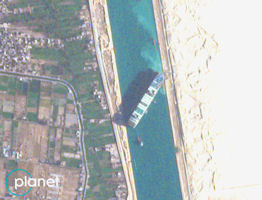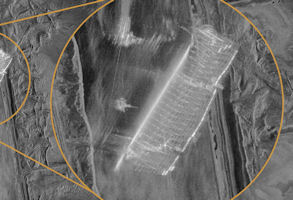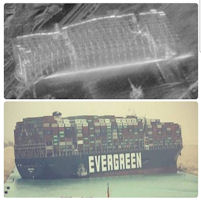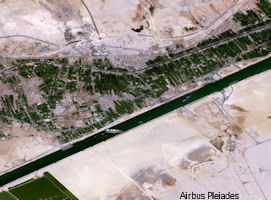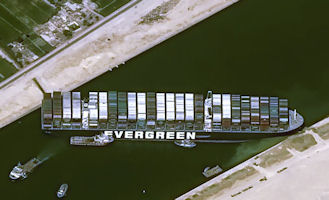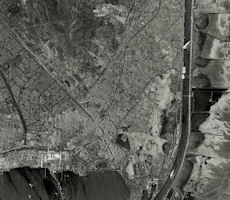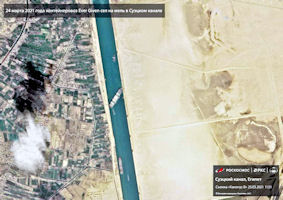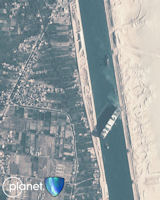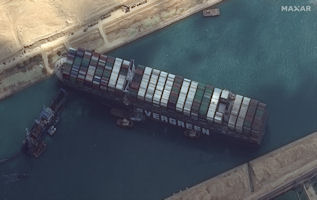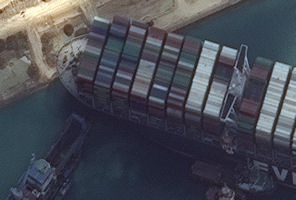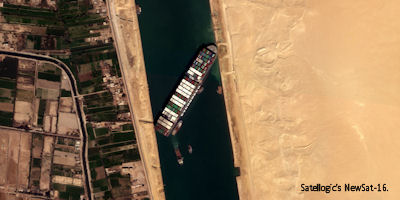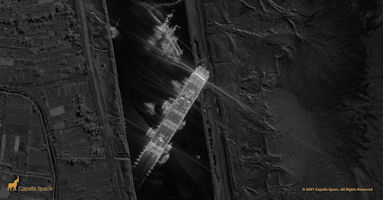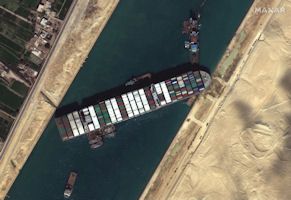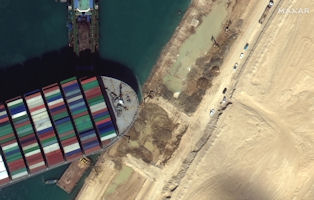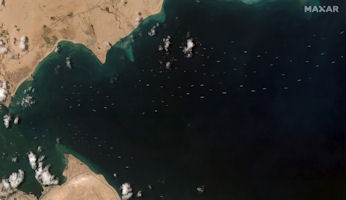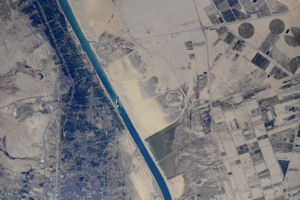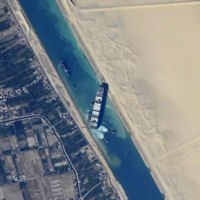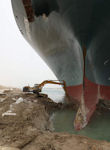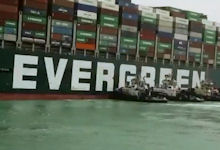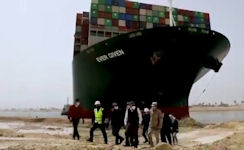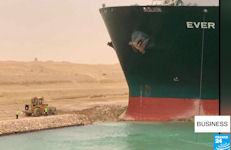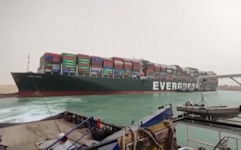Suez Canal - Overview
Strategically and economically one of the most important waterways in the world, the Suez Canal is located in Egypt, and connects connects Port Said on the Mediterranean Sea with the port of Suez on the Red Sea. The Suez Canal provides an essentially direct route for transport of goods between Europe and Asia. The longest canal in the world without locks, the Suez Canal is one of the world's most heavily traveled shipping lanes and the fastest crossing from the Atlantic to the Indian oceans. The Canal is variously reported as between 163 and 195 kilometers (approximately 100-121 miles) long. Because no locks interrupt traffic on this sea level waterway, the transit time from end to end averages about 13-15 hours.
The Suez Canal carries about 2.5 percent of world oil output. Closure of the Suez Canal [and the SUMED Pipeline] would divert oil tankers around the southern tip of Africa, the Cape of Good Hope, adding approximately 6,000 miles to transit, increasing both costs and shipping time. According to a report released by the International Energy Agency (IEA), shipping around Africa would add 15 days of transit to Europe and 8-10 days to the United States.
The Suez Canal has a single lane with several passing zones and no locks. The maximum sailing draft as of 2009 was 62-feet according to the Suez Canal Authority. Some vessels may be constrained by the Suez Canal Bridge which is 223-feet high. The channel accommodates what is known as the Suezmax, which is almost exclusively tankers and has a width of up to 151-feet and 150,000 tons. The existing width can accommodate a vessel of up to 230-feet, but there are few tankers that meet this criterion and can fit within the depth. However, improvements that were completed in 2010 increased the depth to 66-feet. The improvements allow supertankers to pass through.
For comparison, the Panama Canal is a network of artificial channels and locks that connect various lakes. The width of the existing lock chambers (Gatun, Miraflores, and Pedro Miguel) are 110 feet wide by 1,050 feet long. However, the largest vessel that can transit the canal is a Panamax vessel. EM 1110-2-1613 dictates that the maximum sailing dimensions are 105.75 feet (32.2 meters) beam width, 950 feet (289.6 meters) long, and 39.5 feet (12.5 meters) depth in fresh water (less in the dry season) and about 38.5 feet in saltwater. New locks to be completed in 2014 will be 180 feet wide, 1,400 feet long, and 60-feet deep. This means that a post-Panamax vessel capable of sailing through the canal will be up to 160 feet beam, 1,200 feet long, and 50-feet deep.
In the 13th century BC, the pharaohs created a canal linking the Nile River delta and the RedSea. The Suez Canal remained navigable, but was neglected for several thousand years. It was re-excavated or modified many times, then finally abandoned in the 8th century AD. On April 25, 1859, the Compagnie Universelle du Canal Maritime de Suez (Universal Company ofthe Maritime Suez Canal) began re-dredging the canal. The Canal was built under the direction of Ferdinand de Lesseps of France using primarily Egyptian labor. After ten years of construction and costs more than double the original estimate, the Suez Canal opened on November 17, 1869, with a licenseto operate for 99 years at a total cost of $100 million.
The Suez Canal's completion was celebrated by many events, including the commissioning of Verdi's "Aida" for the new opera house and the building of great palaces such as the Omar Khayyam (originally constructed to entertain the French Empress Eugenie, and now the central section of the Cairo Marriott Hotel). Lesseps, who had become a world hero of civil engineering as well as a national icon as the builder of the Suez Canal, believed he could repeat his success with a sea-level canal across the Isthmus of Panama. He discovered too late the exceptional difficulties of the site.
In the late nineteenth century, the British commonly referred to the Suez Canal as the "Lifeline of the Empire" because it provided a strategic shipping route to British colonies, particularly India. In 1875, the Conservative government of Benjamin Disraeli bought the indebted Egyptian ruler Ismail's 44% shareholding in the Suez Canal for �4 million to secure control of this strategic waterway, a channel for shipping between the United Kingdom and India since its opening six years earlier under Emperor Napoleon III. Joint Anglo-French financial control over Egypt ended in outright British occupation in 1882. In 1888 the Convention of Constantinople was signed - "respecting the free navigation of the Suez Maritime Canal" and opening the canal to ships of all nations.
Subsequent wars and skirmishes passed control of the Canal to various powers including the United Kingdom, Egypt, Israel, and the United Nations. In 1956, the Suez Canal was nationalized by the Egyptian Government. On June 5, 1967, during the Six-Day War, it was closed and blockaded against Israel by Egypt. It was reopened on June 10, 1975. A multinational observer force including the United States, Israel, and Egypt currently oversees the Canal, which is owned and maintained by the Suez Canal Authority of the Arab Republicof Egypt. According to the international rules which govern navigation through Suez, Egypt cannot forbid any vessel from passing through the Suez Canal if there is no war between Egypt and that country.
At the mouth of the canal, a large auxiliary channel was formed as part of a new central hub port and industrial zone, known as the East Port-Said Project. Further south, the effects of the Al-Salam (El Salam or "Peace") Canal and North Sinai Agricultural Development Program produced desert converted to irrigated agriculture.
The Al-Salam Canal brings water from the Damietta Branch of the Nile, under the Suez Canal to the Sinai Peninsula. First, the project provided irrigation waters to the area west of the Suez Canal. In October 1997, the culvert under the Suez was completed and water became available for irrigation in Block 1, the Tina Plain Zone (50,000 acres). Fields soon began to appear.
A new [in 2000] extension of canals into the desert to the east feed irrigation in Block 3, the Raba�a Zone. Development of more fields south of the Tina Plain Zone in an area called Block 2, the Southeastern Qantara Zone. Plans call for extending the canal by mid-2002 and irrigating a total of 620,000 acres. The cost of the project was estimated to exceed 7.5 billion Egyptian pounds (about $2 billion). Given the scarcity of water resources in the region and the costs involved, it is not surprising that the project is controversial within and outside Egypt.
A cargo container ship among the largest in the world turned sideways and blocked all traffic in Egypt�s Suez Canal, officials said Wednesday, pushing oil prices up 5% in markets in New York and threatening to disrupt a global shipping system already strained by the coronavirus pandemic. The MV Ever Given, a Panama-flagged container ship that carries trade between Asia and Europe, became grounded Tuesday in the narrow, man-made waterway dividing continental Africa from the Sinai Peninsula. It wasn�t immediately clear what caused the Ever Given to turn sideways in the canal. GAC, a global shipping and logistics company, described the Ever Given as suffering �a blackout while transiting in a northerly direction", without elaborating. Evergreen Marine Corp., a major Taiwan-based shipping company that operates the ship, said in a statement provided to The Associated Press that the Ever Given had been overcome by strong winds as it entered the Suez Canal from the Red Sea but none of its containers had sunk.
Efforts to free a beached container vessel stuck in Egypt's Suez Canal entered a third day on Thursday. The Ever Given ran aground diagonally across the canal during a dust storm on 23 March 2021, blocking traffic in both directions, and there are now fears the vessel could cause serious delays to shipping around the world, with dozens of ships already backed up at either side of the waterway. The costs of the blockage of the Suez Canal continue to pile up, as more than 150 ships were waiting to use the waterway early on 25 March 2021. The ship's Japanese owners apologised to those affected by the delays, while the canal operator renewed efforts to move the vessel. At 11:43 pm on March 24th, local time in Egypt, the "Hesse-1" satellite gave full play to its advantages in all-day and all-weather rapid response and captured the Taiwanese container ship EVER GIVEN still stuck in the Suez Canal. It can be clearly seen from the SAR remote sensing image results of the "Haisi-1" satellite that, affected by the accident of the container ship EVER GIVEN in Taiwan, China, a large number of other shipping ships in the anchorage are queuing to pass through the canal.
Capella�s #SAR constellation captured the Ever Given container ship blocking the Suez Canal with very high resolution 50 cm imagery as of 9:36am local Egyptian time. The image features a SAR artifact called layover. The image places returns based on distance to the satellite. Tall objects are closer and appear in the same place as the ground that is closer, so it looks like they�re laying over on the ground. The SAR shows individual containers on the Evergreen vessel. Imagery from planetlabs at 0530UTC the morning of 25th March showed earthwork around the bow of the EVER GIVEN in the Suez Canal. Run off earth can be seen in the waters from the ongoing work.
An attempt to refloat a megaship blocking Egypt's Suez Canal failed 26 March 2021, the vessel's managers said, as the crisis forced companies to re-route services from the vital shipping lane around Africa. "Another attempt to refloat the vessel earlier today... was not successful," the Singapore-based Bernhard Schulte Shipmanagement (BSM) said in a statement. BSM said "the focus is now on dredging to remove sand and mud from around the port side of the vessel's bow". It said Smit Salvage, a Dutch firm that has worked on some of the most famous wrecks of recent years, confirmed there would be "two additional tugs" arriving by Sunday to assist. "Arrangements are also being made for high-capacity pumps to reduce the water levels in the forward void space of the vessel and the bow thruster room," BSM added.
Russian cosmonaut Sergey Kud-Sverchkov on late Saturday shared footage of what appears to be a profound nightmare for world shipping logistics: the Suez Canal/Ever Given incident. What makes his photos outstanding and unique is that they were taken from the International Space Station (ISS). "One of the most discussed news is the incident in the #SuezCanal", Kud-Sverchkov captioned his tweet 27 March 2021. "One of the world's largest container ships #EverGiven has blocked one of the world's busiest shipping lanes. Specialists are making every effort to restore shipping." One of the pictures embraces the entire Suez Canal - one of the world's two most important commercial waterways, with other pictures showing the gigantic Ever Given ship damming it. One can also spot crews of cranes trying to refloat the vessel on the waterway.
|
NEWSLETTER
|
| Join the GlobalSecurity.org mailing list |
|
|
|


